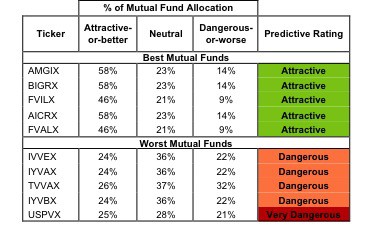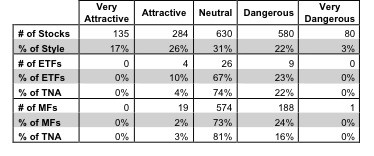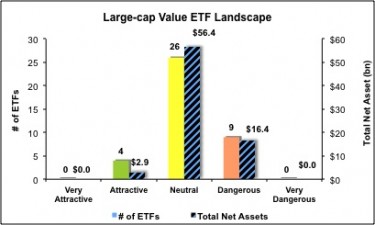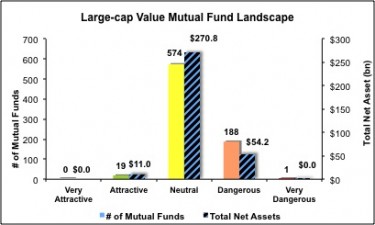The large-cap value style ranks fifth out of the twelve fund styles as detailed in my style roadmap. It gets my Neutral rating, which is based on aggregation of ratings of 39 ETFs and 782 mutual funds in the large-cap value style as of April 24, 2012. Reports on the best & worst ETFs and mutual funds in every sector and style are on my blog and Trading Deck.
Figures 1 and 2 show the five best and worst-rated ETFs and mutual funds in the style. The best ETFs and mutual funds allocate more value to Attractive-or-better-rated stocks than the worst ETFs and mutual funds, which allocate too much value to Neutral-or-worse-rated stocks.
To identify the best and avoid the worst ETFs and mutual funds within the large-cap value style, investors need a predictive rating based on (1) stocks ratings of the holdings and (2) the all-in expenses of each ETF and mutual fund. Investors need not rely on backward-looking ratings. My fund rating methodology is detailed here.
Investors seeking exposure to the large-cap value style should buy one of the Attractive-or-better rated ETFs or mutual funds from Figures 1 and 2.
See ratings and reports on all ETFs and mutual funds in this style on my free mutual fund and ETF screener.
Figure 1: ETFs with the Best & Worst Ratings – Top 5
 * Best ETFs exclude ETFs with less NAV’s less than 100 million.
* Best ETFs exclude ETFs with less NAV’s less than 100 million.
Sources: New Constructs, LLC and company filings
WisdomTree LargeCapValue Fund [s: EZY] is excluded from Figure 1 because its total net assets (TNA) are below $100 million and do not meet our liquidity standards.
Figure 2: Mutual Funds with the Best & Worst Ratings – Top 5
 * Best mutual funds exclude funds with NAV’s less than 100 million.
* Best mutual funds exclude funds with NAV’s less than 100 million.
Sources: New Constructs, LLC and company filings
iShares High Dividend Equity Fund [s: HDV] is my top-rated large-cap value ETF and American Century Quantitative Equity Funds, Inc: Income Growth Fund [s: AMGIX] is my top-rated large-cap value mutual fund. Both earn my Attractive rating by having good portfolio management and low costs.
PowerShares RAFI Fundamental Pure Large Value Portfolio [s: PXLV] is my worst-rated large-cap value ETF and earns my Dangerous rating. World Funds Trust: Union Street Partners Value Fund [s: USPVX] is my worst-rated large-cap value mutual fund and earns my Very Dangerous rating by allocating 49% of its value to neutral-or-worse-rated stocks and charging investors absurdly high total annual costs of 4.22%.
Figure 3 shows that 419 out of the 1709 stocks (43% of the total net assets) held by large-cap value ETFs and mutual funds get an Attractive-or-better rating. This is why only four ETFs and 19 mutual funds earn my Attractive rating. To be investment worthy, ETFs and mutual funds must overweight Attractive-or-better-rated stocks and a 43%allocation to good stocks is not good enough to justify fees, in my opinion.
The takeaways are: mutual fund managers allocate too much capital to low-quality stocks and large-cap value ETFs offer exposure to poor quality stocks.
Figure 3: Large-cap Value Style Landscape For ETFs, Mutual Funds & Stocks
Investors need to tread carefully when considering large-cap value ETFs and mutual funds, as 35 of the 39 ETFs and 763 of the 782 mutual funds earn a Neutral-or-worse rating and should not be bought.
Abbot Laboratories [s: ABT] is one of my favorite stocks held by large-cap value ETFs and mutual funds and earns my Very Attractive rating. The Health Care sector is positioned to capitalize on an aging population and increasing medical costs, which is why I bullish on most Health Care stocks, ETFs and mutual funds. ABT is no exception. ABT has increased profits in each of the past 8 years with an average growth rate of 12%. ABT’s current valuation (~$59.87) implies that profits will permanently decrease by 10%. This divergence of strong performance and low expectations is exactly what I look for in a long position.
FedEx Corporation [s: FDX] is one of my least favorite stocks held by large-cap value ETFs and mutual funds and earns my Dangerous rating. FDX operates in a mature market where most of the margins have been competed away. The company’s meager return on invested capital (ROIC) of 5% places them in the 45th percentile of all Russell 3000 companies. The takeaway is that FDX is a mediocre company in a mediocre industry and doesn’t offer investors an attractive risk/reward tradeoff.
As detailed in “Cheap Funds Dupe Investors”, the fund industry offers many cheap funds but very few funds with high-quality stocks, or with what I call good portfolio management.
Figures 4 and 5 show the rating landscape of all large-cap value ETFs and mutual funds.
Our style roadmap report ranks all styles and highlights those that offer the best investments.
Figure 4: Separating the Best ETFs From the Worst Funds
Figure 5: Separating the Best Mutual Funds From the Worst Funds
Review my full list of ratings and rankings along with free reports on all 39 ETFs and 782 mutual funds in the large-cap value style.
Disclosure: I receive no compensation to write about any specific stock, sector, style or theme.


